Papers by Odalisca Breedy
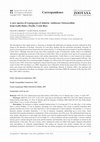
Zootaxa, Feb 3, 2012
The description of this single species is necessary to facilitate the publication of ongoing rese... more The description of this single species is necessary to facilitate the publication of ongoing research conducted by Rita Vargas at the Museum of Zoology, University of Costa Rica, dealing with the associated microfauna. Presently 24 species of Leptogorgia have been reported for the eastern Pacific, 13 of which have been found in Costa Rica (Breedy & Cortés 2011). Although octocoral surveys have been conducted as part of biodiversity studies, there is no published information regarding the occurrence of this taxon in Golfo Dulce. Here we describe a new species of Leptogorgia and compare it with other Leptogorgia species with similar characteristics. Golfo Dulce is a bay located on the southern Pacific coast of Costa Rica. It is about 50 km long, 10-15 km wide, and covers an area of approximately 680 km². The inner part of Golfo Dulce has a maximum depth of slightly over 200 m with a 60 m deep sill at the opening to the Pacific Ocean (Cortés 1999). It has been considered a tropical fjord because of the bathymetry and the presence of anoxic deep waters (Cortés 1999, Svendsen et al. 2006). Specimens were collected by Scuba diving, preserved in 70% ethanol or air dried, and treated and identified following the current methodology (Breedy & Guzman 2002). The holotype and paratypes are deposited in the

Zenodo (CERN European Organization for Nuclear Research), Dec 31, 2009
The species of the gorgoniid genus Eugorgia that occur along the eastern Pacific are taxonomicall... more The species of the gorgoniid genus Eugorgia that occur along the eastern Pacific are taxonomically revised based on original type material of all species described until now, and reference specimens from recent surveys and expeditions. The genus Eugorgia is characterised by having a dominance of double disc sclerites in the coenenchyme which separate this taxon from the other gorgonians with similar external morphology such as Leptogorgia. In this revision, 12 species are recognized as valid and one is synonymised, E. forreri. Lectotypes were assigned for two species in order to establish their taxonomic status, and three varieties were established as species, E. alba, E. excelsa and E. purpurascens. All the species are described and illustrated. Based on the morphology of colonies and sclerites and supported by a phylogenetic analysis, we recognised three species groups within the genus Eugorgia: the "ampla-group" consisting of eight species, with slightly raised polyp-mounds and dichotomous branching or irregular variations of it; the "daniana group", consisting of three species, with prominent polyp-mounds and pinnate-like branching; and the "rubens-group" consisting of a single species, E. rubens, which is closely related to species within the second group. The fauna herein reported does not represent the diversity or geographical range of the species because more surveys are needed and more material stored in museums needs attention to complete the regional assessment.
Journal of the Marine Biological Association of the United Kingdom, Jul 25, 2008
Leptogorgia ignita is a new gorgonian species characterized by its conspicuous bright orange colo... more Leptogorgia ignita is a new gorgonian species characterized by its conspicuous bright orange colour, irregular branching pattern and combination of sclerite types in the coenenchyme, all of the same orange colour, with abundance of capstans and blunt spindles, and less abundant acute spindles. The species was found in a shallow water coral community, 4-12 m deep in Samara Bay, Pacific Costa Rica. Morphologically, L. ignita belongs to the L. rigida-group comprising eight species for the group; 13 Leptogorgia species are known for Costa Rica, and 23 for the entire eastern Pacific. The new species is described, illustrated and compared to the other valid taxa of the group.
FIGURE 4. Adelogorgia telones, USNM 57455 (lemon-yellow paratype)(A) colony; (B) detail of the br... more FIGURE 4. Adelogorgia telones, USNM 57455 (lemon-yellow paratype)(A) colony; (B) detail of the branches; (C) sclerites.

Research Square (Research Square), May 19, 2023
Most biodiversity studies of octocorals have focused on tropical shallow waters, particularly fro... more Most biodiversity studies of octocorals have focused on tropical shallow waters, particularly from Mexico to Peru, and more recently in Chile. The rst description of a Chilean octocorals dates back to the H.M.S Challenger expedition in 1873-1876. Since then, only few descriptions of new soft coral species from this region have been published. In addition, the taxonomic status of most gorgonians reported from the temperate Paci c coast of South America is dubious due to the loss of the original type material for most taxa. Here, we use morphological characters and nuclear and mitochondrial markers to reevaluate the taxonomy of the Chilean gorgonians Phycogorgia fucata and Leptogorgia chilensis, and describe a new species named Leptogorgia pichicuyensis sp.n. We present the rst description of their latitudinal distribution patterns. Our results support the monophyly of the Chilean gorgoniids investigated, and the provisional placement of P. fucata with other species of the genus Leptogorgia in the absence of further specimens of Phycogorgia in GenBank. Our distribution analyses reveal a clear biogeographic break congruent with the Central Chile and Araucanian marine ecoregions. Overall, our study provides the rst integrative taxonomic study of Southern Eastern Paci c cold-water gorgonians suggesting a higher number of species than expected for this underexplored region.
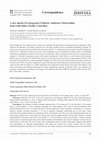
Zenodo (CERN European Organization for Nuclear Research), Dec 31, 2012
The description of this single species is necessary to facilitate the publication of ongoing rese... more The description of this single species is necessary to facilitate the publication of ongoing research conducted by Rita Vargas at the Museum of Zoology, University of Costa Rica, dealing with the associated microfauna. Presently 24 species of Leptogorgia have been reported for the eastern Pacific, 13 of which have been found in Costa Rica (Breedy & Cortés 2011). Although octocoral surveys have been conducted as part of biodiversity studies, there is no published information regarding the occurrence of this taxon in Golfo Dulce. Here we describe a new species of Leptogorgia and compare it with other Leptogorgia species with similar characteristics. Golfo Dulce is a bay located on the southern Pacific coast of Costa Rica. It is about 50 km long, 10-15 km wide, and covers an area of approximately 680 km². The inner part of Golfo Dulce has a maximum depth of slightly over 200 m with a 60 m deep sill at the opening to the Pacific Ocean (Cortés 1999). It has been considered a tropical fjord because of the bathymetry and the presence of anoxic deep waters (Cortés 1999, Svendsen et al. 2006). Specimens were collected by Scuba diving, preserved in 70% ethanol or air dried, and treated and identified following the current methodology (Breedy & Guzman 2002). The holotype and paratypes are deposited in the
Bulletin of Marine Science, Jul 1, 2013
ABSTRACT Our knowledge of octocoral diversity in the eastern Pacific has been focused on shallow ... more ABSTRACT Our knowledge of octocoral diversity in the eastern Pacific has been focused on shallow reef habitats, while the fauna occurring in the mesophotic zone from 40 to 150 m is poorly known. A new species of the gorgoniid Eugorgia was recently obtained with a submersible from the Hannibal Bank, a coastal seamount 60 km off mainland Panama and 15 km from Coiba Island. The morphological characters were analyzed and illustrated by light and scanning electron microscopy. Eugorgia siedenburgae sp. nov. can be distinguished from the other species in the genus by its bushy, multiplanar, bicolored colony, and the sclerites colors, composition, and sizes. This new species increases the number in the genus to 13 and contributes to our understanding of the fragile mesophotic biodiversity.

ZooKeys, Aug 19, 2020
The species of the genus Psammogorgia Verrill, 1868 from the shallow waters of the tropical easte... more The species of the genus Psammogorgia Verrill, 1868 from the shallow waters of the tropical eastern Pacific were mainly described from 1846 to 1870. Very few contributions were published subsequently. Recently, the genus was revisited with the addition of two new species. However, a comprehensive generic study is still missing for the eastern Pacific. Psammogorgia is characterised by having axes cores without mineralisation, mainly coarse irregular spindles and thorny, leafy or tuberculate clubs coenenchymal sclerites and the anthocodial armature with distinct collaret and points arrangements. Herein a taxonomic revision of the genus is presented based on type material which was morphologically analysed and illustrated using optical and scanning electron microscopy. Comparative character tables are provided for comparison among species in the genus, along with a taxonomic key. Moreover, the taxonomic status of each species was analysed. The genus Psammogorgia comprises six valid species and two varieties, and three lectotypes and a new combination are proposed to establish the taxonomic status of these species.
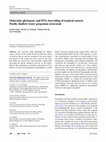
Marine Biology, Feb 23, 2014
Pacific octocorals remain poorly studied. Here, using partial mitochondrial MutS and igr1-COI seq... more Pacific octocorals remain poorly studied. Here, using partial mitochondrial MutS and igr1-COI sequences, we provide a phylogenetic assessment of a broad sample of eastern Pacific shallow-water octocorals and investigate their phylogenetic relationships with Caribbean gorgonians. We corroborate the monophyly of Pacifigorgia, Leptogorgia and Eugorgia and provide evidence of a close relationship between Swiftia and Psammogorgia, currently placed in Plexauridae. In addition, the phylogenies obtained here provide insights into the historical biogeography and phylogenetic diversity of the eastern Pacific octocoral assemblages and on character evolution among this diverse faunal assemblage. Finally, we evaluate the classification power of Dna barcoding for identifying species of shallow-water eastern Pacific octocorals and assess the use of a nuclear intron (SrP54) to supplement traditional mitochondrial barcodes in this group of organisms.
Zootaxa, Mar 8, 2007
The species of the widespread gorgoniid genus Leptogorgia, which occur along the eastern Pacific,... more The species of the widespread gorgoniid genus Leptogorgia, which occur along the eastern Pacific, are taxonomically revised based on original type material of all species described until now and reference specimens from recent surveys and expeditions along the Pacific coast of Panama, and Costa Rica. As a result, 21 species are recognized as valid and one as dubious. Lectotypes are assigned for eight species in order to establish their taxonomic status. All the species are BREEDY & GUZMAN 4 • Zootaxa 1419 © 2007 Magnolia Press described and illustrated. The fauna herein reported does not represent overall diversity or geographical range of each species but adds new reports. The present count is 16 species for Panama,
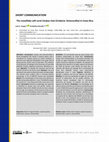
Cuadernos de investigación UNED, Jun 6, 2022
Introduction: Carijoa riisei (Clavulariidae) is found throughout the world in tropical waters and... more Introduction: Carijoa riisei (Clavulariidae) is found throughout the world in tropical waters and is considered an invasive species at certain locations. A specimen was collected intertidally in the upper Gulf of Nicoya estuary, Pacific coast of Costa Rica. The collection of the Museum of Zoology of the University of Costa Rica (MZUCR) includes additional specimens identified as C. riisei. Objective: To identify the specimen and list the MZUCR records for the Pacific coast. Methods: The coral was kept in sea water to allow observation of open polyps. The sclerites were studied under a scanning electron microscope. A list of MZUCR records was assembled. Results: The morphologies of the colony and sclerites are similar to those described for C. riisei. The MZUCR includes 50 records of C. riisei along the Pacific coast and at Coco Island. Conclusions: Based on morphology, the specimen is identified as Carijoa riisei, but genetic studies are desirable. Most of the UCRMZ records are from a decade or more ago. An evaluation of the presence of this coral in both the Pacific and Caribbean coasts is needed to better establish its present ecological role in Costa Rica.
Bulletin of Marine Science, Apr 1, 2012
The gorgoniid genus Leptogorgia is found along the Pacific coast of Mexico; 10 species have been ... more The gorgoniid genus Leptogorgia is found along the Pacific coast of Mexico; 10 species have been reported from Baja California and Acapulco. Leptogorgia ena sp. nov. is a new shallow-water species found at 5-12 m depth at various high energy rocky sites along the coast of San Pedro Pochutla District, Oaxaca. Specimens of the new species were collected by scuba diving and the morphological characters were analyzed and illustrated under light and scanning electron microscopy. The new species can be distinguished from the others by the very small colony, dominance of wide capstans, barrels and double heads, low occurrence of spindles, spindles measuring < 0.10 mm, and presence of tentacular sclerites. With this report, the genus Leptogorgia increases to 11 species for Mexico and 26 for the eastern Pacific.
Cuadernos de investigación UNED, Nov 30, 2021
Introduction: The Gulf of Nicoya is the most important estuary on the Pacific coast of Costa Rica... more Introduction: The Gulf of Nicoya is the most important estuary on the Pacific coast of Costa Rica. Information on the presence of soft corals is scattered in the literature and in museum collections. Objective: To provide a list of soft corals reported for the estuary. Methods: We compiled the literature (2002-2020) and of the specimens deposited at the Museum of Zoology, University of Costa Rica. Results: Thirty species have been reported for the estuary (Clavulariidae, Gorgoniidae and Plexauridae). Most were collected on the eastern coast of the Nicoya Peninsula, and several species were described based on estuary specimens. Conclusion: The 30 species represent 79 % of those reported for Costa Rica. Despite this relatively high percentage, the sampling effort has been modest and other sites within the estuary should be explored.

Three new species of Chrysogorgia were discovered from seamounts in the tropical Western Pacific ... more Three new species of Chrysogorgia were discovered from seamounts in the tropical Western Pacific Ocean. Chrysogorgia dendritica sp. nov. and Chrysogorgia fragilis sp. nov. were collected from the Kocebu Guyot of the Magellan Seamount chain with the water depth of 1,821 m and 1,279-1,321 m, respectively, and Chrysogorgia gracilis sp. nov. was collected from a seamount adjacent to the Mariana Trench with the water depth of 298 m. They all belong to the Chrysogorgia "group A, Spiculosae" with rods distributed in body wall and tentacles, and differ from all congeners except C. abludo Pante & Watling, 2012 by having a tree-shaped colony (vs. bottlebrush-shaped, planar or biflabellate). Chrysogorgia dendritica sp. nov. is unique in having a monopodial stem, the 1/3L branching sequence and the amoeba-shaped sclerites (sclerites branched toward to many directions) at the body bases of polyps. Chrysogorgia fragilis sp. nov. is most similar to C. abludo, but differs by the regular 1/3L branching sequence and elongate flat scales in coenenchyme. Chrysogorgia gracilis sp. nov. is easily separated from congeners by the 1/4L branching sequence, the absence of sclerites in the basal body wall, and the very sparse scales in coenenchyme. Based on the phylogenetic and genetic distance analyses of mtMutS gene, all the available Chrysogorgia species were separated into two main groups: one includes C. binata, C. cf. stellata and C. chryseis, which have two or more fans emerging from a short main stem (bi-or multi-flabellate colony); the other one includes all the species with the branching patterns as a single ascending spiral (clockwise or counterclockwise, bottlebrush-shaped colony), a fan (planar colony) and a bush of branches perched on top of a long straight stem (tree-shaped colony). Additionally, the tree-shaped colony represents a new branching pattern in Chrysogorgia, and therefore we extend the generic diagnosis.
Marine Biodiversity, Dec 1, 2021

Zootaxa, Jul 7, 2009
The species of the gorgoniid genus Eugorgia that occur along the eastern Pacific are taxonomicall... more The species of the gorgoniid genus Eugorgia that occur along the eastern Pacific are taxonomically revised based on original type material of all species described until now, and reference specimens from recent surveys and expeditions. The genus Eugorgia is characterised by having a dominance of double disc sclerites in the coenenchyme which separate this taxon from the other gorgonians with similar external morphology such as Leptogorgia. In this revision, 12 species are recognized as valid and one is synonymised, E. forreri. Lectotypes were assigned for two species in order to establish their taxonomic status, and three varieties were established as species, E. alba, E. excelsa and E. purpurascens. All the species are described and illustrated. Based on the morphology of colonies and sclerites and supported by a phylogenetic analysis, we recognised three species groups within the genus Eugorgia: the "ampla-group" consisting of eight species, with slightly raised polyp-mounds and dichotomous branching or irregular variations of it; the "daniana group", consisting of three species, with prominent polyp-mounds and pinnate-like branching; and the "rubens-group" consisting of a single species, E. rubens, which is closely related to species within the second group. The fauna herein reported does not represent the diversity or geographical range of the species because more surveys are needed and more material stored in museums needs attention to complete the regional assessment.
Revista De Biologia Tropical, 1988
Coricuma nicoyensis gen.et sp. nov . (Crustacea, Cumacea) is described from material collected du... more Coricuma nicoyensis gen.et sp. nov . (Crustacea, Cumacea) is described from material collected during 1984 at the Punta Morales intertidal mud flat (> 30% silt + clay), Gulf of Nicoya (10° N, 85° W), Costa Rica. The exact placement of the new genus is problematical and for the present time is assigned to the Bodotriinae. This is the sixth cumacean described from the Pacific coast of the Americas between California and Tierra del Fuego.
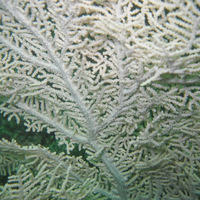










Uploads
Papers by Odalisca Breedy